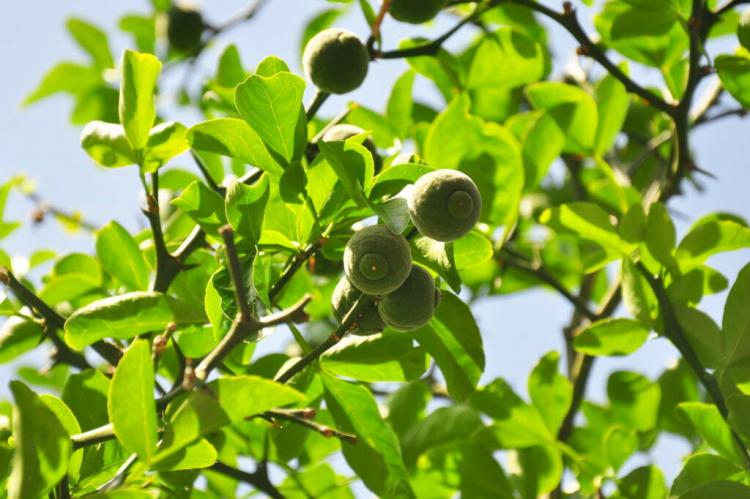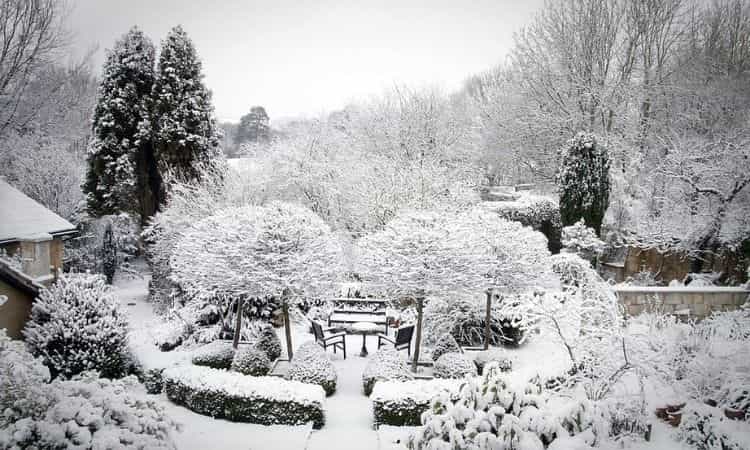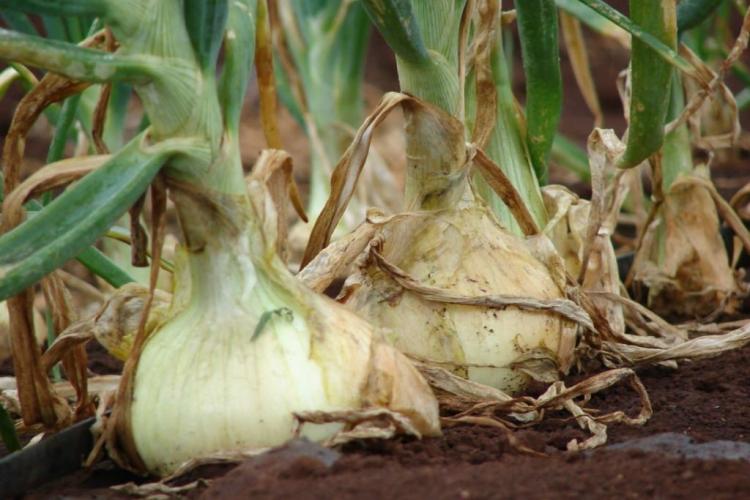Wintering The Orange Tree: Tips And Tricks
In summer an orange tree feels good even in our latitudes. But it has to be well prepared for the winter. You can use these tips to overwinter your orange tree.
Orange trees ( Citrus x sinensis ) originally come from the subtropical regions of China or Southeast Asia. Accordingly, they are not adapted to the cool temperatures in winter in this country. The citrus plant, which once originated from a cross between mandarins ( Citrus reticulata ) and grapefruit ( Citrus maxima ), must therefore be overwintered in a frost-free place. But how can orange trees overwinter undamaged? We present everything you need to know about winter protection for sensitive plants.
Hibernate the orange tree properly
Table of Contents
To enable overwintering in a frost-free room, you should plant your orange tree in a container that you can easily transport. Because orange trees can grow to a stately size over time, sooner or later transport will only be possible with a hand truck or even heavier equipment.
At what temperatures does it become critical for the orange tree?
Orange trees are not frost-hardy due to their origin. So when does the orange tree have to go into winter quarters? In general, you should try to keep the orange outdoors as long as possible. If the first-night frosts are announced or temperatures are permanently below 5 ° C, you should take your orange tree to a sheltered place for the winter. When this is the case depends on the region in which you are cultivating your orange tree.
But there can also be big differences from street to street: Gardens on the unprotected, wind-facing outskirts, in cool valley floors, or at high altitudes, for example, can unfortunately hardly rely on the weather forecast. Therefore, when it comes to wintering, you should rely on your own experience.

Protect the orange tree from the cold
The easiest way to protect an orange tree from the cold in winter is to overwinter in a frost-free place. It is not advisable to overwinter an orange tree outdoors as there is insufficient protection from frost. Unheated winter gardens or well-sealed greenhouses with frost guards are ideal rooms to overwinter your orange tree. If this is not available to you, an unheated, bright staircase or an attic with many windows is also suitable.
If temperatures below 5 ° C occur briefly in your room, it is advisable to wrap the root ball with a coconut mat. Depending on the region, the orange tree can leave its winter quarters after the last frost in April or May.
You might so like: Strawberry Tree: The Best Types And Tips For Planting In The Garden
Wintering the orange tree: the optimal conditions
Both the temperature and the light conditions are decisive for the selection of winter quarters. The winter temperature is ideally between 5 and 10 ° C. If the thermometer falls permanently below 5 ° C, there is a risk of cold damage. If the temperatures rise above 15 ° C, the winter dormancy is interrupted, which hinders the flowering induction and thus the flowering and fruiting in the coming year. It is therefore not advisable to overwinter the orange tree in the living room or apartment.
The relationship between temperature and light is decisive for the successful wintering of your orange tree. The higher the temperature, the more energy the tree needs and the more photosynthesis your orange tree has to carry out. Therefore, the higher the temperature, the it needs more light. Since the light intensity is often low in winter, we recommend that you aim for a temperature of around 5 ° C.

Tip: If the temperature and light supply are well-matched, this offers the best conditions for good overwintering. Orange trees that are wintered in very cool conditions can also stand darker, while the slightly warmer wintered trees need sufficient light.
Maintain orange tree in winter
For the orange tree to survive the winter well, the correct care in the winter quarters is also crucial.
Water, repot and cut the orange tree in winter
In winter you should keep the root ball of your orange tree slightly moist. But what does it exactly mean? In general, when wintering orange trees, we recommend watering less than too much. It is best to wait until the upper quarter of the root ball has dried out before watering. You should water when the first leaves roll up at the latest.
You can use the wintertime to repot your orange tree. Between February and March is the optimal time to plant the tree in a slightly larger container. This is necessary about every three years. About the demands on the soil and the planter, the orange tree does not differ from other citrus trees. We, therefore, recommend repotting our article on the topic of lemon trees for more tips.
In addition, spring, shortly before the new shoots, is the ideal time to bring the crown of your orange tree back into shape. In general, orange trees should not be pruned regularly. If you want to prune your orange tree, you should only shorten individual shoots and avoid a strong step backward. However, you should completely remove dead shoots.

Fertilizing is not recommended in winter, as too much fertilizer could stimulate the plant to grow. However, this is undesirable during hibernation and is also not beneficial for the plant in the long term. For a strong budding in spring, however, you should ensure a good supply of nutrients after the winter rest.
It is therefore advisable to do the first fertilization about two weeks after you have taken the orange tree out of winter quarters. Depending on the location, this is usually in April. This allows the plant to get used to the new location before fertilizing. Make sure you use a predominantly organic fertilizer that is tailored to the needs of citrus fruits.
Our Gardender organic citrus and Mediterranean fertilizer not only ensures that your orange tree is optimally nourished but also helps to keep it healthy and resilient. The organic liquid fertilizer is also safe for pets and garden animals.
You might so like: Bergamot: Everything About Planting, Caring For And Using The Fruit
The orange tree loses leaves in winter: what to do
Leaf loss often occurs on orange trees during the winter. The cause for this can be narrowed down based on the point in time: If the leaf loss occurs immediately after moving into the winter roost, the temperature difference between the place outside and the winter roost was probably too great. Then a partial loss of the leaves has to be accepted since a new switch would cause additional stress. Leaf loss should stop within a few days as the plant adjusts to the new conditions.
If the leaf falls a few weeks after the orange tree is set to winter quarters, a lack of light is most likely the cause. We recommend looking for a location that is as bright as possible or lowering the temperature at the location, as the plant will then get by with less light. Alternatively, additional lighting with a plant lamp can ensure that light and temperature are again in a more suitable relationship to one another.

If leaves do not fall until February, this is often because direct sunlight hits the orange tree. The plant evaporates more water than it can absorb with the roots, which are still very cold. If you take the plant out of the direct sun, leaf fall should stop.
Pests in winter quarters
Another challenge when wintering orange trees are pests. These are usually introduced into the winter quarters with the plants and can then multiply quickly due to the lack of beneficial insects and good living conditions. Orange trees in winter quarters are mainly attacked by lice and the red spider. In our special articles, we have put together helpful tips for controlling scale insects, mealybugs, and spider mites.
Basically, it is better not to use synthetic pesticides on your orange trees, especially if you want to harvest fruit from them. Our Gardender organic pest-free neem is an alternative based on natural raw materials that you can safely use in winter. Many well-tried home remedies also work well. As a preventive measure, you should strictly check the plants before moving them to their winter quarters and, if necessary, treat them directly. It also makes sense to keep your orange tree in the winter at a temperature of close to 5 ° C to slow down the multiplication of pests.
At a glance: Caring for orange trees properly in winter
- Water when a quarter of the root ball is dry
- Repot in February to March
- Keep pruning to a minimum
- Spring fertilization in April with a predominantly organic fertilizer
- Possible leaf loss due to excessive temperature changes, lack of light or direct sunlight
- Check before wintering; Air temperature of around 5 ° C reduces the multiplication of pests
- Natural crop protection products or home remedies can be used to control pests
Are there hardy orange trees?
Orange trees ( Citrus x Sinensis L.) are generally not winter hardy. But if you are less interested in the sweet fruits than in the Mediterranean look, there is actually an alternative for your garden: the three-leaved orange ( Poncirus trifoliata ), also known as bitter orange. Three-leaved oranges can tolerate winter temperatures down to below -18 ° C, but unfortunately, the fruits are very sour to bitter and therefore inedible. As a decorative tree in the garden, however, it is definitely worth considering.

We have put together many other exciting tips and information about the orange tree for you in our special article.






